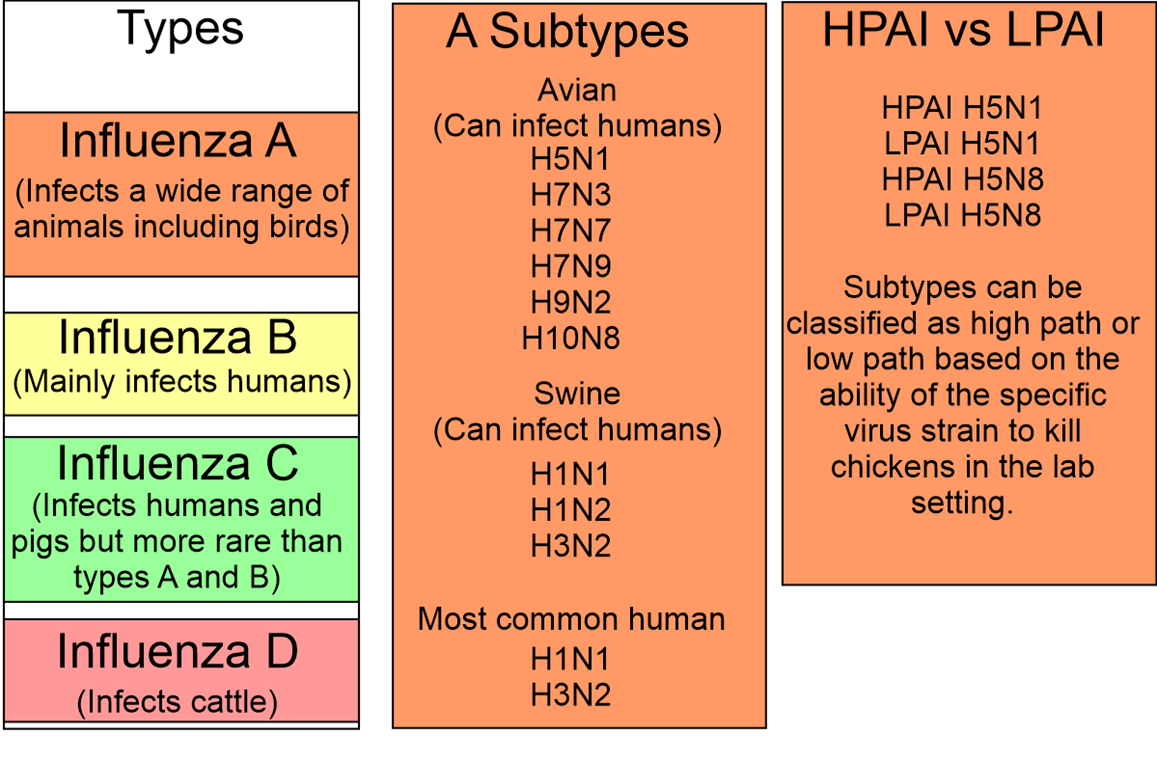Important Facts For Prelims
Bird Flu Outbreaks in Mammals
- 17 Jul 2023
- 4 min read
Why in News?
The recent surge in bird flu outbreaks among mammals has alarmed international agencies, including the Food and Agriculture Organization (FAO), the World Health Organization (WHO), and the World Organisation for Animal Health(WOAH, founded as OIE).
- The agencies express concern that as mammals are biologically closer to humans than birds, the virus could potentially adapt to infect humans more easily.
What is Bird Flu?
- About:
- Bird flu or Avian influenza refers to the disease caused by infection with avian influenza Type A viruses.
- Infrequently, the virus can infect mammals from birds, a phenomenon called spillover, and rarely can spread between mammals.
- Outbreak in Wild Birds and Poultry:
- The most common type of bird flu virus is H5N1, which belongs to the goose/Guangdong-lineage of H5N1 avian influenza viruses that first emerged in 1996/1997.
- Since 2020, this virus has caused an unprecedented number of deaths in wild birds and poultry in many countries in Africa, Asia, Europe and the Americas.
- In 2022, WOAH reported H5N1 high pathogenicity avian influenza outbreaks in poultry and wild birds in 67 countries across five continents.
- These outbreaks resulted in the loss of over 131 million domestic poultry due to death or culling in affected farms and villages.
- An additional 14 countries have reported outbreaks in 2023.
- Outbreaks in Mammals and Potential Hazard for Humans:
- Since 2022, approximately 10 countries have reported cases of avian flu outbreaks in both land and sea mammals.
- Examples include farmed mink in Spain, seals in the United States, and sea lions in Peru and Chile.
- These outbreaks have been documented in 26 species, with the recent detection of H5N1 in cats in Poland.
- There is a concern that infected mammals may serve as mixing vessels for influenza viruses, potentially leading to the emergence of new, more harmful viruses that could affect both animals and humans.
- However, the WHO has only received reports of a few mild cases in people who had close contact with infected birds.
- Since 2022, approximately 10 countries have reported cases of avian flu outbreaks in both land and sea mammals.
- Status in India:
- With effect from September 3, 2019, the World Organization for Animal Health declared the India free from the Avian Influenza (H5N1).
- However, in December 2020 and early 2021, outbreaks of avian influenza H5N1 and H5N8 were reported in poultry in 15 states in India.
- Urgent Measures to Curb the Spread: To mitigate the risks associated with bird flu outbreaks, the international agencies including FAO, WHO, WOAH recommended the following measures:
- They urged countries to share genetic data of viruses from humans and animals in publicly accessible databases.
- Enhancing biosecurity measures and applying good hygiene practices in farms and poultry value chains.
- Ensuring rapid detection, reporting, and response to animal outbreaks.
- Strengthening influenza surveillance in both animals and humans.
- Conducting thorough epidemiological and virological investigations around animal outbreaks and human infections.
- Promoting collaboration between animal and human health sectors.
UPSC Civil Services Examination, Previous Year Question (PYQ)
Q. H1N1 virus is sometimes mentioned in the news with reference to which one of the following diseases? (2015)
(a) AIDS
(b) Bird flu
(c) Dengue
(d) Swine flu
Ans: (d)







